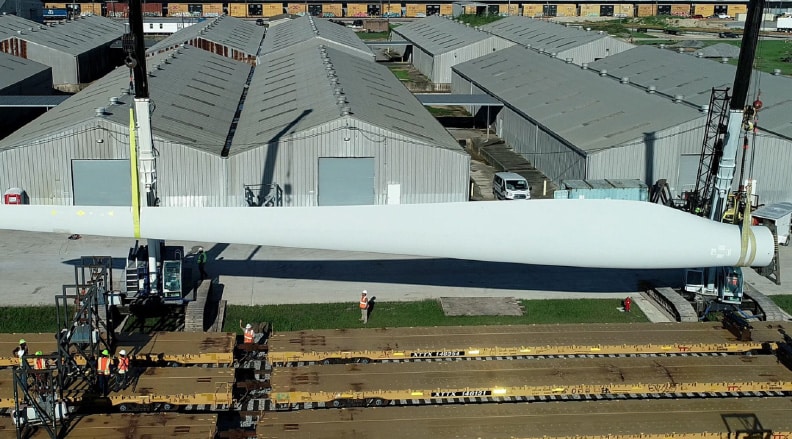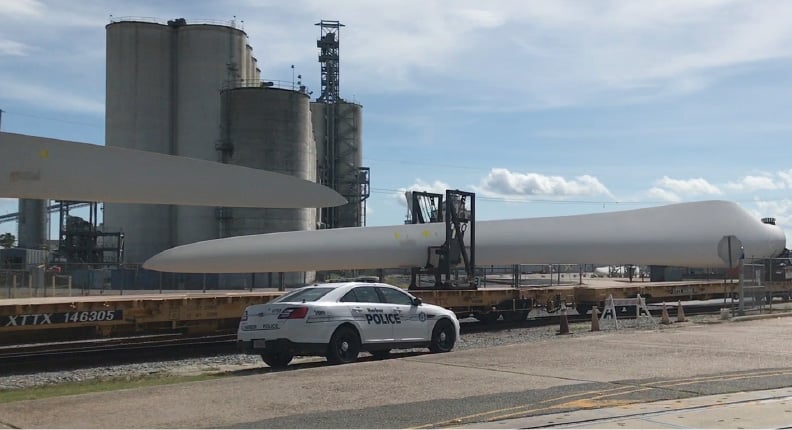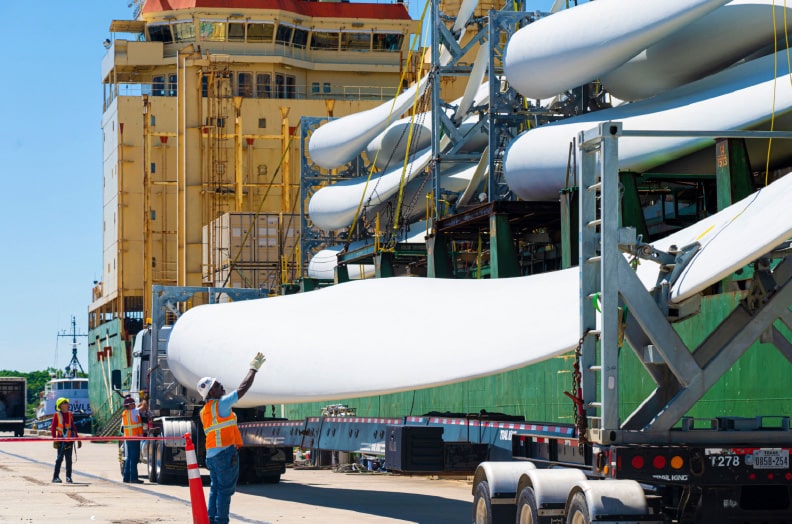And Once Delivered From The Port Of Lake Charles, They’ll Turn In The Wind To Generate Power
What on Earth are those huge, white, feather-shaped objects we see gliding along the railroad tracks at Sallier Street — and easing down Lake Street, pulled by snorting big rigs?

They are future windmills. They’re the blades for them, specifically. They’re giant components for wind turbines that generate green, renewable power, using free fuel — wind.
The Port of Lake Charles now regularly handles shipments of these blades. It’s an item that many ports wouldn’t be able to move. Port Executive Director William J. “Bill” Rase III says the blades are the latest example of how Lake Charles can handle cargo that’s beyond the capabilities of other ports.
Handle With Care
The blades are 138 to 144 feet long and weigh about 11 tons each. The sizes vary, but they’re all massive — so they require considerable space for handling when they arrive at the port.

For example, one recent load of blades was shipped out by port rail after arriving at Berth 2 of the City Docks.
For each load, the blades were placed on special double-length rail cars — think of big-city buses that flex in the middle, to handle turns — for final delivery. From there, they were taken carefully by train to destinations inland.
One of the recent final destinations of these blades was a wind farm in the state of Iowa, which generates 40 percent of all its power from wind — the highest rate in the nation. Other blades went to Texas, which leads the U.S. in wind-power capacity.
Once delivered, the blades are assembled into towering, power-generating windmills — they’re about half the height of the Eiffel Tower — that increasingly dot the landscape of America.
The unusually large components will continue to be a frequent — and eye-catching — sight for motorists along Ryan Street, Enterprise Boulevard, La. 14 and other routes that intersect the rail route.
All Eyes Watching
The port’s capabilities for handling specialty breakbulk and project cargo continues to gain local, national and global attention.
The latest example is from the British-based trade journal Heavy Lift & Project Forwarding International.
“Ramping up its wind energy activity is Louisiana’s Port of Lake Charles, officially named the Lake Charles Harbor and Terminal District, which handled its first shipment of wind turbine blades,” the story notes. “The demolition of two antiquated warehouses and the addition of a rail yard to its City Docks facilities in 2018 have enabled Lake Charles to accept wind turbine blades and components. Those changes were part of a $200 million capital improvement plan spanning five years. The Port of Lake Charles — which Forbes magazine ranked as the seventh-fastest growing seaport in America — is seeing an increase in heavy lift and project cargoes generally.”
The port’s Dan Loughney worked to bring the windmill blade cargo to Lake Charles.
“The reason for these shipments and volumes is the widespread economic development under way in this area,” Loughney said. “More than $108 billion in industrial projects have recently been completed, are underway, or have been announced in the Lake Charles area. Most projects are the construction and development of energy-related facilities. Of those, $43 billion of these projects are under way. Continued construction is estimated through 2025, with many of the modules and much of the equipment coming in from overseas.”
At the port, things are always moving, whatever the day — by ship, crane, conveyor, truck and rail. It’s heavy, exacting, big-shoulder work.
The blades are a high-profile example of how the port anchors America’s emerging Energy Corridor.
You’ve seen the road signs downtown that guide trucks off Lake Street to the City Docks, but that’s only part of the port story. There are multiple Port terminals, actually:
— The City Docks, which can accommodate up to a dozen ships at a time.
— The Automated Terminal at the City Docks, which incorporates a 189,000-square-foot warehouse.
— Bulk Terminal 1, handling more than 3.1 million metric tons of dry bulk material annually.
— Bulk Terminal 4, specializing in aggregate, which moves 1 million metric tons each year.
A Century Of Progress
Much like the famous Walt Disney World attraction Carousel of Progress — the ever-moving ride that sings of “a great big beautiful tomorrow, shining at the end of every day” — Southwest Louisiana had ambitions exactly 100 years ago that were, as the Disney song goes, “just a dream away.”

The actions would begin at the start of a new year, 1920 — exactly one century ago — with organized talks about how to build a deepwater port on the Calcasieu River. Today, the port and Calcasieu Ship Channel are the brain and backbone of America’s Energy Corridor — and wind turbine blades are among the 21st-century cargo.
The Port of Lake Charles has had — and continues to have — a significant impact on the character and economy of Southwest Louisiana.
The creation of the Calcasieu River Ship Channel to provide a deepwater port at Lake Charles has attracted dozens of industries over the years, and now the industrial complex lining the channel has emerged as “America’s Energy Corridor” — one that continues to get busier.
The presence of the port has long spurred industrial growth in the Lake Charles area, and today the port’s activities continue to bring jobs, commerce and investment.
Cargo and industrial facilitation are the meat-and-potatoes work of the port team, while the key to global port access is the Calcasieu Ship Channel and its route to and from the Gulf of Mexico.
Big Wheels Keep On Turning
When there’s work to do, Southwest Louisiana gets the job done. That’s seen all along the Lake Charles Harbor and Terminal District. There’s 56 million tons of cargo (inbound and outbound) handled each year along the Calcasieu Ship Channel.
“Waterways are crucial for global trade and the economy,” Nasdaq notes in its report on world shipping commerce. “The global marine port and service market is expected to reach an estimated $87.8 billion by 2023.”
The port seeks more than just windmill blades in the time ahead.
It was a major exhibitor in the 30th annual Breakbulk Americas 2019 conference recently in Houston. More than 5,000 people attended. The event allowed the port to connect with fellow providers and the region’s leading oil-and-gas and petrochemical project owners, top industrial manufacturers, mining companies and metals producers who are moving cargoes throughout the Americas and around the world.
Although the port will mark its 94th birthday later this year, its focus is on the future — fueled by forward-thinking leadership and an ambitious five-year plan of capital improvement projects. It’s the same kind of initiative that launched the Port in the first place — and made it an instant anchor of the Southwest Louisiana economy.
“We work hard to make sure our facilities and our services make economic sense for companies,” Rase said. “We’re an efficient transportation hub.”















Comments are closed.